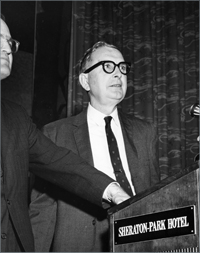John H. Williams (1908-1966) was a Canadian-American physicist.
Williams transferred to Los Alamos in early 1943 and was among the first group of scientists to arrive on the Hill. He played a crucial role in getting Los Alamos organized, equipped, and ready for work on the atomic bomb. Williams joined the experimental physics division (headed by Robert Bacher) as head of the Electrostatic Generator Group. On July 15, John H. Williams’ Electrostatic Generator Group (P-2) observed neutrons from the fission of plutonium-239. Just two years later, the first atomic bomb would be tested.
Williams was responsible for the two University of Wisconsin Van de Graaff generators at Los Alamos. He also served as Kenneth Bainbridge’s deputy director for the first atomic bomb test in 1945 as leader of the Services Division, where he oversaw all special equipment, wiring, power, transportation, technical personnel, communication facilities, and construction for the test.
On July 16, 1945 at 4:45 a.m. at the Trinity Test site, Williams was waiting at South 10,000 when Kenneth Bainbridge phoned him with the order, “Prepare to fire at five-thirty.” With ten seconds left, “Williams and George Kistiakowsky dashed from the control shelter. Williams squatted behind a ridge of dirt and Kisty clambered on top of a bunker.” Although they were almost two miles from the blast, they were among the few men who were relatively close to the atomic blast.
Scientific Contributions
Williams published important early work on the widths and intensities of x-ray lines and later became a research assistant to Professor John T. Tate at the University of Minnesota. There, while carrying a full teaching load, Williams headed an effort to build a Van de Graaff generator and to finance a program of interdisciplinary research.
In 1940, many prominent faculty members across the United States left their university posts to accept defense-related positions. At the time, Williams was still a Canadian citizen, so he could not yet participate in defense-related research. Upon obtaining U. S. citizenship in early 1942, he began working on neutron cross-section measurements related to the atomic bomb project.
Later Years
After the war ended, Williams worked on the Bikini nuclear test series and eventually returned to the faculty of the University of Minnesota in 1946. Many graduate students worked with him using the rebuilt Van de Graaff generator until 1967 when it was finally retired. Williams was widely respected and considered a very strong advocate for the improvement and modernization of the school’s research facilities.
During the early 1950s, Williams was instrumental in creating the Midwest Universities Research Association (MURA), dedicated to the study, design, and construction of a significant high-energy facility in the Midwest.
In 1958 he was appointed Director of the Atomic Energy Commission’s Research Division, and in this position he represented the needs of science to the Congress. After only one year in this role, President Eisenhower appointed him as an Atomic Energy Commissioner. Despite continuing treatment for cancer, he continued to serve the AEC until 1960, when he resigned to return to the University of Minnesota for more cancer treatment.





